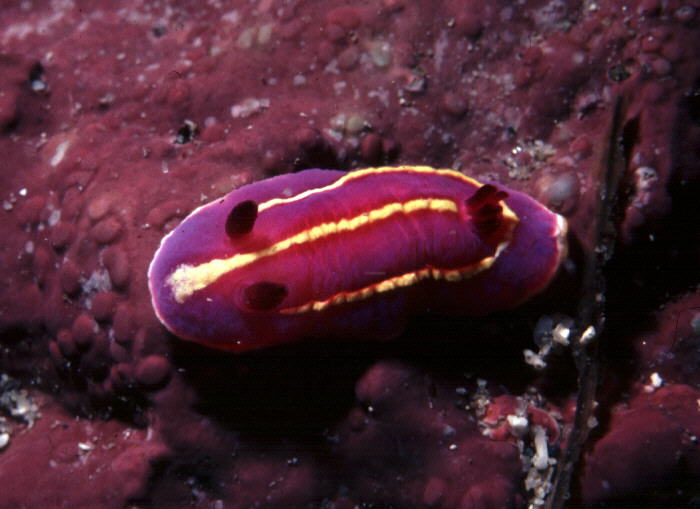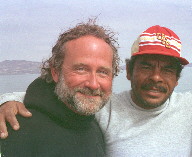 |
Chromodoris macfarlandi
South Coronados Island, Mexico, Sept. 1979
Photo courtesy of Dr. Hans Bertsch
Chromodoris macfarlandi Cockerell, 1901
Ninety-nine years ago, Theodore Dru Allison Cockerell published a paper in
Nature entitled "Pigments of nudibranchiate Mollusca." His paper initiated
several simple controversies: when were the 3 species named, and what is
the correct spelling of the species named in honor of Frank Mace MacFarland?\
Ahh, the rules of the International Commission on Zoological Nomenclature
(ICZN) to the rescue--with a lesson to all! Cockerell had intended to name
his 3 new species of Chromodoris in an article submitted to The Nautilus
(which was eventually published in July 1902); however, his manuscript on
pigments was published in 1901. F.M. MacFarland (1966: 382) succinctly
stated in his bibliographic reference to Cockerell's 1901 "pigment" paper,
"Chromodoris macfarlandi, Chromodoris porterae, and Chromodoris
universitatis mentioned and sufficiently described to be recognizable. For
fuller description see The Nautilus, vol. 16, no. 2, pp. 19-21, June,
1902." The moral (or lesson) harkens back to words of wisdom that I first
heard from the late Dr. Rudolf Stohler at one of the initial meetings of
the Western Society of Malacologists (what a grand gentleman and Mentor
Parliamentarian he was!)--never mention an unnamed species name in a talk
or abstract. It might be published in such a manner as to establish
priority for the species's name, and maybe even under another's authorship.
The rules of description and priority are clear. Cockerell inadvertently
broke these rules; but at least he named the species he intended to name.
The spelling of its name needs a brief comment. The ICZN states that patronyms of people whose names begin with Mc- should be spelled as species with mac-. Even I erred on that one. Cockerell misspelled it with "mc" and I falsely concurred with him. But then that is the essence of science--mistakes can be corrected by oneself or others. We are not bound by intransigent fundamentalist categories.
This beautiful little animal is about 25-35 mm in total length. It occurs from Monterey, California, USA, to Bahía Magdalena, Baja California Sur, México (Bertsch, 1978). It is rare in the northern parts of its range, but seems more common in southern California. Years ago I was working a low tide at Tomatillo, Baja California, with colleagues from the Universidad Autónoma de Baja California (Unidad de Ciencias Marinas, Ensenada), and found 20+ specimens rolling rocks. That is almost more than I have found in all my years of scuba diving the coasts of California and Baja California. During a two-day span in December 1985 on Isla Cedros, I collected Chromodoris macfarlandi and two of its tropical congeners, Chromodoris galexorum and Chromodoris norrisi.
The coloration of Chromodoris macfarlandi is uniquely foudroyant (one of my favorite words to describe the lightning brilliance of nudibranch coloration). Let me quote Frank Mace MacFarland's description of this species (1966: 436), which served as the figure caption to his wife Olive Hornbrook MacFarland's delicately beautiful drawing of the animal: "The coloring is most lovely and the gradations of tone unusual. The general ground color is a deep violet, rose madder, and permanent blue, paler in the mid-dorsal and foot areas. Cadmium orange edges the entire mantle, bounding a submarginal white band which merges with the violet of the body."
Although there have been many references to Chromodoris macfarlandi (see McDonald, 1983 for a summary), almost nothing is known of its biology. Bloom (1976) erroneously stated that it fed on the spiculate sponges Gellius sp. and Halicona sp. However, a marvelous chemical study by Molinski & Faulkner (1986) more than shed doubt on this comment (based on their analysis of spongin diterpenes). Just this year, Goddard (2000) described finding Chromodoris macfarlandi on two species of aplysillid sponges,Aplysilla glacialis and A. polyraphis at La Jolla, California.
Bertsch (1978: 315-316) described the radular teeth of Chromodoris macfarlandi. The combined radular formula is 36-76 (16-50.1.16-50) with positive correlations between the number of tooth rows and the maximum number of teeth per half-row, between the number of tooth rows and radular length, and between the number of teeth per half-row and radular width.
Scanning electron micrographs of the radula illustrate developing teeth.
The innermost lateral teeth
, teeth from the middle of the half row,
and the outermost radular teeth vary in typical
chromodorid fashion.
References:
Bertsch, Hans. 1978. The Chromodoridinae nudibranchs from the Pacific
coast of America.--Part II. The genus Chromodoris. The Veliger 20 (4):
307-327.
Bloom, S.A. 1976. Morphological correlation between dorid nudibranch
predators and sponge prey. The Veliger 18 (3): 289-301.
Cockerell, Theodore Dru Allison. 1901. Pigments of nudibranchiate
Mollusca. Nature 65: 79-80.
-----. 1902. Three new species of Chromodoris. The Nautilus 16: 19-21.
Goddard, Jeff. 2000. Sponge prey of Chromodoris macfarlandi.
Opisthobranch Newsletter 26 (2): 9-10.
MacFarland, Frank Mace. 1966. Studies of opisthobranchiate mollusks of
the Pacific coast of North America. California Academy of Sciences,
Memoirs 6: 1-546 pp.
McDonald, Gary R. 1983. A review of the nudibranchs of the California
coast. Malacologia 24 (1-2): 114-276.
Molinski, T.F., and D. John Faulkner. 1986. Three new rearranged spongin
diterpenes from Chromodoris macfarlandi: reappraisal of the structures of
dendrillolides A and B. Journal of Organic Chemistry 51: 4564-4567.
Taxonomic Information and photos courtesy of Dr. Hans Bertsch

Assoc. Prof. |
